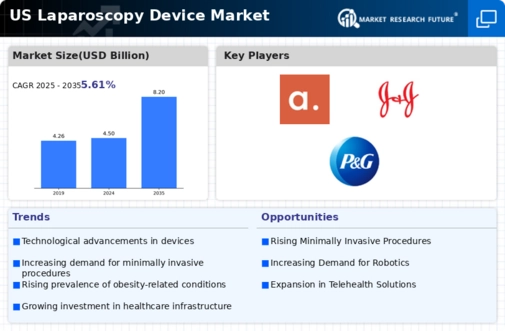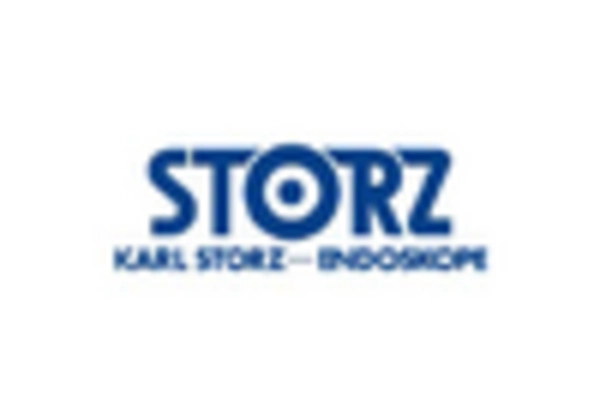Surge in Healthcare Expenditure
Healthcare expenditure in the US has been on an upward trajectory, which is anticipated to positively impact the laparoscopy device market. With the US spending over $4 trillion annually on healthcare, there is a growing emphasis on adopting advanced medical technologies that enhance surgical outcomes. Increased funding for hospitals and surgical centers allows for the procurement of state-of-the-art laparoscopic devices, which are essential for performing complex procedures with precision. This financial commitment to healthcare innovation indicates a robust market environment for laparoscopic technologies. As healthcare providers seek to improve patient care and operational efficiency, the laparoscopy device market is likely to benefit from this surge in investment.
Growing Awareness of Patient Safety
There is a heightened awareness regarding patient safety and the quality of surgical procedures, which serves as a significant driver for the laparoscopy device market. Patients are increasingly informed about the risks associated with traditional open surgeries, leading to a preference for minimally invasive options. Laparoscopic procedures are associated with fewer complications, shorter hospital stays, and quicker recovery times, which align with patient safety concerns. This shift in patient expectations is prompting healthcare providers to adopt laparoscopic techniques more widely. As a result, the laparoscopy device market is likely to see an uptick in demand as hospitals prioritize patient-centered care and invest in technologies that enhance safety and efficacy.
Expansion of Surgical Training Programs
The expansion of surgical training programs focusing on minimally invasive techniques is a crucial driver for the laparoscopy device market. As more medical schools and residency programs incorporate laparoscopic training into their curricula, the number of skilled surgeons proficient in these techniques is likely to increase. This trend is essential for the growth of the laparoscopy device market, as a well-trained surgical workforce is necessary to effectively utilize advanced laparoscopic technologies. Furthermore, the establishment of simulation-based training programs allows for hands-on experience without compromising patient safety. As the surgical community embraces these educational advancements, the demand for laparoscopic devices is expected to rise, reflecting a commitment to enhancing surgical practices.
Increasing Prevalence of Chronic Diseases
The rising incidence of chronic diseases such as obesity, diabetes, and cardiovascular conditions is a notable driver for the laparoscopy device market. As these health issues become more prevalent, the demand for surgical interventions that can be performed using minimally invasive techniques is likely to increase. According to recent data, approximately 40% of adults in the US are classified as obese, which correlates with a higher likelihood of requiring surgical procedures. This trend suggests that healthcare providers may increasingly turn to laparoscopy as a preferred method due to its benefits, including reduced recovery time and lower complication rates. Consequently, the laparoscopy device market is expected to experience growth as hospitals and surgical centers invest in advanced laparoscopic technologies to meet the needs of this expanding patient population.
Technological Integration in Surgical Practices
The integration of advanced technologies such as robotics and artificial intelligence into surgical practices is transforming the landscape of the laparoscopy device market. Robotic-assisted laparoscopic surgeries are gaining traction due to their precision and ability to enhance surgical outcomes. The market for robotic surgical systems is projected to reach $20 billion by 2026, indicating a strong trend towards technological adoption in surgical settings. This integration not only improves the capabilities of laparoscopic devices but also attracts a new generation of surgeons who are trained in these advanced techniques. Consequently, the laparoscopy device market is poised for growth as hospitals invest in these innovative technologies to remain competitive and improve patient care.

















Leave a Comment